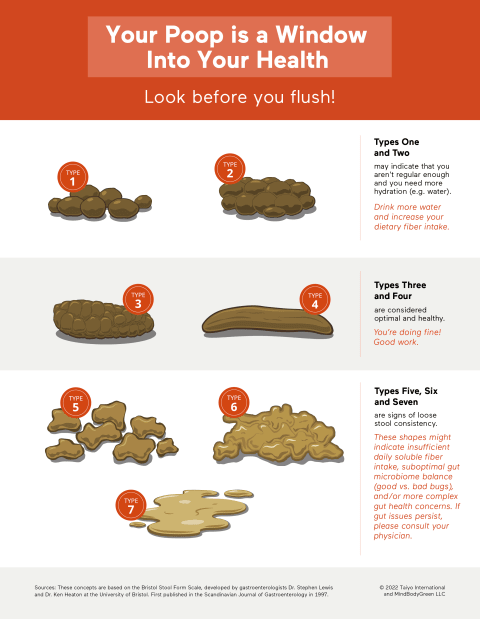Advertisement
Is Your Poop Healthy & Normal? Here's How To Tell


We're all about destigmatizing bowel movements here at mindbodygreen. Poop can serve as a window into your gut health, immune function, and mental well-being. So it's worth taking note of its frequency, consistency, and even color. Trust.
Signs of a healthy poop
While "normal" poop varies in shape and color, scientific research and clinical consensus outline a specific range of appearances that indicate optimal nutrition inputs (think fiber!), hydration, smooth digestion, gut microbiome balance, and detoxification health and processes.
When it comes to color, a shade of brown is optimal. To determine if the size and shape of your poop are ideal, you can consult the science-based scale and gold standard for monitoring the stool spectrum: the Bristol Stool Chart. (Of course, this requires you to actually look before you flush.)
This stool scale breaks forms down into seven different types of poop:
- Type 1: Hard, small lumps that look almost like little pebbles or rabbit pellets; difficult to pass
- Type 2: Log-shaped but lumpy and a bit hard
- Type 3: Log-shaped with a few cracks on the surface, easy to pass.
- Type 4: Smooth and snake-like, easy to pass
- Type 5: Soft blobs with clear-cut edges, very easy to pass
- Type 6: Fluffy, mushy pieces with ragged edges, too easy to pass
- Type 7: Watery with no solid pieces, clear indicator stool is moving through your bowels very quickly

Types 1 and 2 indicate your bowel movements' transit time is too long and infrequent. Types 5, 6, and 7 suggest your stool is moving through your GI tract far too quickly. Ideally, you want to be passing types 3 and 4 the majority of the time.
What suboptimal poop looks like
While your bowel movements are bound to change (i.e., due to inconsistent fiber intake, inadequate hydration, menstrual cycle, stress, health issues, and more), there's a range of shapes and colors that indicate your digestion is subpar. Poop clues, if you will.
While they can be startling, nutrient-related color changes in our stool (like red stool appearing after a beet salad or black stool when taking iron supplements) are considered normal. That said, any color outside of brown—including red, green, yellow, white, and black—can potentially indicate a more serious health issue and may be cause for concern and follow-up with a health care provider.
Failing to hydrate properly can lead to infrequent bowel movements, which often come in the form of types 1 and 2. On the other hand, pooping too frequently and seeing types 5, 6, and 7 in the toilet bowl most of the time can indicate suboptimal gut health. Interestingly, both sides of the scale (i.e., hard pebbles you strain to pass and too-frequent loose stools) can demonstrate a need for more fiber in your diet.
When it comes to regularity, remember the 3-3 Rule: You should be pooping no more than three times a day, and no less than once every three days. While that cadence will vary from person to person, perhaps the ideal stool goal is to have at least one daily bowel movement that looks like type 3 or 4 in a shade of brown.
How to get your digestive health back on track
According to NutriScience® chief science officer Michael Lelah, Ph.D., adding more fiber to your diet is one of the best ways to promote healthy bowel movements. "Fiber promotes regularity. It helps the body to produce stool that is not hard or soft," he says.
There are two broad types of fiber (soluble and insoluble). Soluble fiber helps slow the digestive process, contributing to satiety, blood sugar balance, regularity, and more. Certain soluble fibers also serve as prebiotic nourishment for beneficial bacteria residing in our gut.
Insoluble fiber helps build stool bulk and supports motility by speeding up gut transit time. It's important to include both types of fiber in your diet via a variety of fiber-rich plant sources.
Since 95% of Americans are failing to meet our daily fiber needs (and by a wide margin), a quality supplement with organic plant fibers is a simple and effective way to bridge that fiber gap.
When choosing a fiber supplement, integrative registered dietitian Whitney Crouch, RDN, CLT, recommends starting your search with your specific poop health goal in mind. "There are a few types of fiber supplements available, so knowing your goal with using a supplement is important. Decide if you need more bulk or softer stools," she says.
From there, you can narrow down your search. "Trying to bulk up and improve regularity? Try a psyllium, guar bean, or methylcellulose product," Crouch says. If you have specific GI health concerns, Crouch recommends limiting or avoiding FODMAPS like fructooligosaccharides (FOS).
A premium daily fiber supplement that features soluble and insoluble plant fibers, like mindbodygreen's organic fiber+ with prebiotic support, is a smart way to promote healthy digestion, gut motility, stool form, and regularity.*
The takeaway
Taking a look at your poop before you flush is a great way to monitor your gut health (which impacts whole-body health). Refer to the Bristol Stool Chart types, and take note of your stool form and regularity. Going too often (more than three times a day) or not enough (less than three times a week) can be a sign that your gut isn't getting the nutrients it needs, with fiber and water topping the list.
Adding more fiber to your nutrition ritual—with a plant-plentiful dietary approach and a quality supplement, like mbg's organic fiber+ with prebiotic support—can help support healthy bowel movements, keep things moving along, and help your gut microbiome thrive.*
